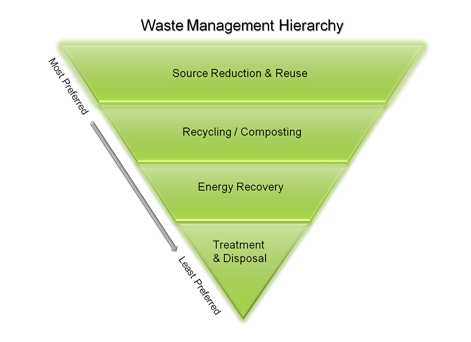What is in Disaster Debris
Disaster debris is the material and waste streams resulting from natural or human-made disasters. These disasters range from hurricanes and typhoons, flooding, wildfires, droughts, landslides, and earthquakes to animal disease outbreaks. Chemical spills, nuclear power plant accidents, and terrorist attacks involving conventional, chemical, radiological, or biological agents are types of disasters caused by humans.
Materials can either be safely reused as is or be recycled or composted to allow those resources to be used in the most productive way. This keeps resources within the circular economy. A circular economy reduces material use, redesigns materials to be less resource and carbon intensive, and recaptures “waste” as a resource to manufacture new materials and products.
On the other hand, waste generally means any garbage or refuse resulting from industrial, commercial, mining, and agricultural operations and from community activities. Wastes normally get disposed of in landfills or thrown in incinerators where they lose any usefulness they might otherwise have had. Communities can plan for and determine how disaster debris is managed.
On this page:
List of Debris Streams
Natural or human-made disasters can leave behind a broad range of debris streams, or types, that communities may have to manage. Response activities may produce additional materials and wastes, which may be contaminated, that need to be managed after a disaster (e.g., aqueous waste from decontamination activities, personal protective equipment (PPE) from sampling and analysis activities). Below are some common debris types, although there may be many others, depending on the characteristics of the community and the disaster:
- Ammunition and explosives.
- Animal carcasses.
- Asbestos-containing material (e.g., asbestos pipe wrap, insulation, siding, and ceiling and floor tiles).
- Ash.
- Asphalt and concrete.
- Biological-contaminated debris.
- Building contents (e.g., furniture, personal property).
- Chemical-contaminated debris.
- Commingled debris (i.e., a mixture of many debris types, such as vegetative debris, construction and demolition debris, household hazardous waste, and building contents).
- Construction and demolition debris (e.g., building materials, such as mixed metals, masonry materials, concrete, lumber, and asphalt shingles).
- Cylinders and tanks.
- Electronics.
- Food.
- Hazardous Waste.
- Household Hazardous Waste (e.g., batteries, pesticides, solvents, paint thinners, mercury-containing devices).
- Lead-based painted building materials.
- Marine or waterway debris.
- Medical waste.
- Metals.
- Mixed waste (i.e., waste containing both radioactive and hazardous waste components).
- Municipal solid waste (e.g. trash or garbage consisting of everyday items we use and then throw away, such as product packaging, clothing, bottles).
- PCB-containing waste (e.g., transformers, capacitors, other electrical equipment).
- Pharmaceuticals.
- Radiological-contaminated debris.
- Scrap tires.
- Soils, sediments, and sandbags.
- Treated wood (e.g., utility poles, fencing, decks).
- Used oil and oil-contaminated debris.
- Vegetative debris.
- Vehicles and vessels.
- White goods (i.e., household appliances, such as stoves, refrigerators, washers/dryers, air conditioner units).
Material or Waste
With the actions taken before, during, and after a disaster, each community can decide whether a particular debris stream is managed as a material, waste, or both. Although there may be a strong interest to manage some debris streams solely as wastes, like contaminated debris, medical waste, and commingled debris, it does not have to be an all-or-nothing approach.
Decisions may depend on disaster debris planning, the type of disaster, the amount of each debris stream generated, the community’s existing material and waste management infrastructure, the ability to segregate the debris into different debris streams after a disaster, and available capacities at material and waste management facilities, among other factors.
The more planning that is done before a disaster, the more likely the debris will be segregated into different debris streams to recover more resources, reduce waste, and support a circular economy. Planning provides the community with an opportunity to assess the capabilities of their existing waste management infrastructure, including reuse and recycling and composting facilities, and make improvements to it or find alternative options, if necessary. The goal should be to try to manage the debris as sustainably as possible to keep the materials within the economy.
Why It Matters
For purposes of planning and management, debris is too broad of a term. Because disaster debris can contain a broad range of categories of items – anything from ammunition and explosives to contaminated debris to white goods – different regulations, health and safety considerations, and management strategies may apply. Keeping debris streams mixed together while planning and cleaning up likely means the debris will be landfilled. In contrast, separating debris into its different types makes more management options available, including reuse, recycling, and composting, allowing communities to optimally plan for and manage each category.
An important goal of debris management in any disaster is to manage the debris as sustainably as possible to reduce the amount of waste and preserve valuable, limited resources and landfill space. To increase the sustainable management of debris, communities should use EPA’s four-tiered Waste Management Hierarchy to guide debris management decision-making.

EPA’s Waste Management Hierarchy ranks the various management options from most to least environmentally preferred. The hierarchy places emphasis on reducing, reusing, recycling, and composting as key to the sustainable management of debris. Many disasters, including those involving chemical, biological, or radiological agents, may present opportunities for more sustainable management options. Expert planning and oversight are needed to ensure harmful materials are safely managed. The more planning that is done before a disaster, the more likely these opportunities can be realized.
The sustainable management of disaster debris can have impacts far beyond waste. Waste disposal can result in health and environmental impacts. When materials are safely reused, recycled, and composted, greenhouse gas emissions are also reduced.
